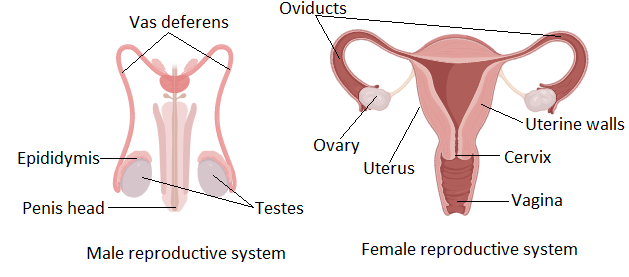Answer
406.8k+ views
Hint: The human male and female reproductive system together make the human reproductive system. The sperms are male gametes formed by the male reproductive system. Ovum or eggs are female gametes produced by the female reproductive system. Humans have defined sexual differentiation.
Complete answer: The primary human male sexual organ called testes is the site of the production of sperms. The testes are oval-shaped paired organs that lie enclosed in the scrotum. Inside the testes is the complex network of tubules called seminiferous tubules. These tubules consist of mother gamete cells that form sperms through spermatogenesis. The testes also secrete a male hormone called testosterone which is required for sperm formation and regulation of secondary sexual characters in males.

The primary sexual organs of the female reproductive system are called ovaries. These are two paired irregularly spherical structures present on both sides of the lower abdominal region. The ovaries release eggs which are female gametes. The gametes are received by a tubular structure called the fallopian tube. The fallopian tube is an elongated structure that extends towards both ovaries and connects centrally to the uterus. The fallopian tube is also called the oviduct. So, the oviduct is the site of fertilization as the egg stays in it for 24 hours till fertilization.
If the egg gets fertilized by a sperm, it is travelled down the oviduct to reach the uterus. Implantation of the egg occurs in the uterine walls after 4 to 5 days. Once implanted in the uterus, the embryo establishes a connection with the mother through a disc-shaped tissue called the placenta. The growing embryo takes nourishment through the placenta. The placenta involves a rich blood supply from the mother’s body to the embryo. Waste materials are also exchanged through the placenta.
Note: Every month one of the ovaries releases an egg. If the eggs get fertilized, it will follow the path to embryo formation. If it will not get fertilized, it will degrade. This causes the uterine wall to shed off which was made to receive a zygote in case of fertilization. This causes menstruation in females.
Complete answer: The primary human male sexual organ called testes is the site of the production of sperms. The testes are oval-shaped paired organs that lie enclosed in the scrotum. Inside the testes is the complex network of tubules called seminiferous tubules. These tubules consist of mother gamete cells that form sperms through spermatogenesis. The testes also secrete a male hormone called testosterone which is required for sperm formation and regulation of secondary sexual characters in males.

The primary sexual organs of the female reproductive system are called ovaries. These are two paired irregularly spherical structures present on both sides of the lower abdominal region. The ovaries release eggs which are female gametes. The gametes are received by a tubular structure called the fallopian tube. The fallopian tube is an elongated structure that extends towards both ovaries and connects centrally to the uterus. The fallopian tube is also called the oviduct. So, the oviduct is the site of fertilization as the egg stays in it for 24 hours till fertilization.
If the egg gets fertilized by a sperm, it is travelled down the oviduct to reach the uterus. Implantation of the egg occurs in the uterine walls after 4 to 5 days. Once implanted in the uterus, the embryo establishes a connection with the mother through a disc-shaped tissue called the placenta. The growing embryo takes nourishment through the placenta. The placenta involves a rich blood supply from the mother’s body to the embryo. Waste materials are also exchanged through the placenta.
Note: Every month one of the ovaries releases an egg. If the eggs get fertilized, it will follow the path to embryo formation. If it will not get fertilized, it will degrade. This causes the uterine wall to shed off which was made to receive a zygote in case of fertilization. This causes menstruation in females.
Recently Updated Pages
Mark and label the given geoinformation on the outline class 11 social science CBSE

When people say No pun intended what does that mea class 8 english CBSE

Name the states which share their boundary with Indias class 9 social science CBSE

Give an account of the Northern Plains of India class 9 social science CBSE

Change the following sentences into negative and interrogative class 10 english CBSE

Advantages and disadvantages of science

Trending doubts
Which are the Top 10 Largest Countries of the World?

Fill the blanks with the suitable prepositions 1 The class 9 english CBSE

Difference between Prokaryotic cell and Eukaryotic class 11 biology CBSE

Differentiate between homogeneous and heterogeneous class 12 chemistry CBSE

How do you graph the function fx 4x class 9 maths CBSE

The Equation xxx + 2 is Satisfied when x is Equal to Class 10 Maths

Select the word that is correctly spelled a Twelveth class 10 english CBSE

Give 10 examples for herbs , shrubs , climbers , creepers

What organs are located on the left side of your body class 11 biology CBSE



